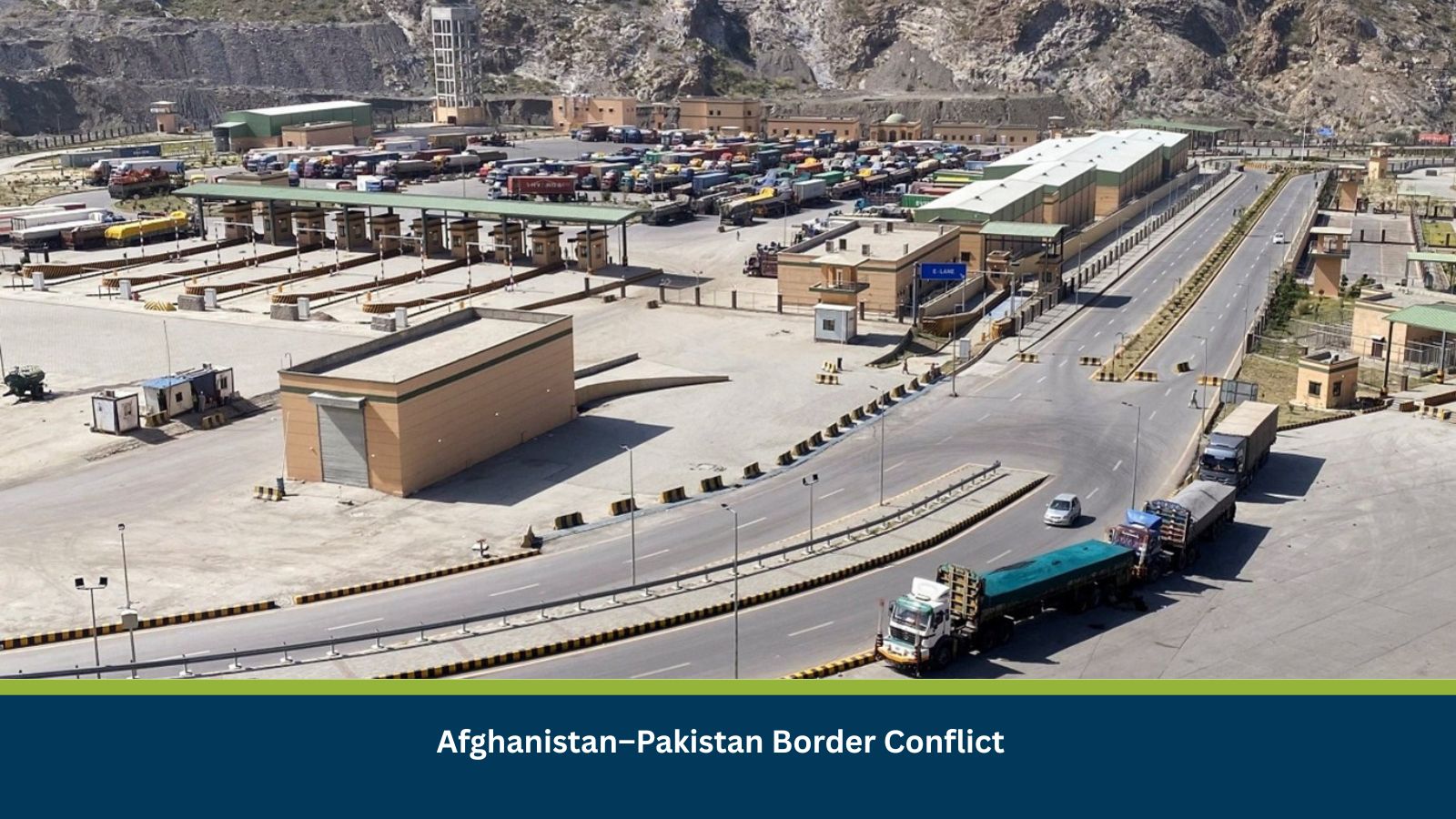Renewed Fighting Along the Border
Fresh violence has erupted along the Afghanistan–Pakistan border, marking one of the deadliest escalations between the two neighbours in recent years. On 15 October 2025, intense clashes broke out between Afghan Taliban forces and the Pakistani military in the Spin Boldak district of Afghanistan and the Chaman district of Pakistan’s Balochistan province.
Since 14 October, more than 50 fatalities including both civilians and military personnel have been reported on both sides. The Afghan Taliban claimed significant territorial gains, including the destruction of a Pakistani military post, seizure of armoured vehicles, and capture of strategic positions. They also accused Pakistani shelling in Spin Boldak of killing 15 civilians and injuring over 100 others.
In contrast, Pakistan’s military asserted that its forces repelled Taliban offensives, inflicting heavy casualties and regaining control of several outposts. The Afghanistan–Pakistan border conflict has led to widespread displacement, infrastructure damage, and disrupted trade across key crossing points.
Airstrikes and Diplomatic Mediation
The latest escalation follows a Pakistani aerial assault on Kabul on 09 October, targeting Tehreek-e-Taliban Pakistan (TTP) elements. Precision strikes near Abdul Haq Square in District 8 caused major explosions and panic across Kabul. Witnesses reported debris falling in areas such as Pul-e-Mahmood Khan and Shar-e-Naw, prompting emergency restrictions.
Both sides accuse each other of initiating unprovoked attacks. Pakistan alleges that Afghan forces instigated the fighting, while the Taliban have condemned Pakistan’s cross-border shelling as an act of aggression.
Following two days of violence, both nations agreed to a temporary 48-hour ceasefire on 15 October, brokered through mediation by Qatar and Saudi Arabia. The agreement reflects mounting international pressure to contain the Afghan–Pak clashes, with regional partners urging restraint and de-escalation.
Genesis of the Current Crisis
The Afghanistan–Pakistan border conflict has deep roots in a series of tit-for-tat military operations and deteriorating diplomatic ties:
- August 2025: Pakistan launched airstrikes on Taliban and TTP camps inside Afghanistan, citing cross-border militant incursions.
- September 2025: Bilateral relations worsened as Pakistan accused the Taliban of sheltering anti-Pakistan elements, while Kabul denounced the strikes as violations of sovereignty.
- Early October 2025: Islamabad sealed key crossings at Torkham and Chaman, halting trade and civilian movement.
- 10–13 October 2025: Hostilities escalated into sustained artillery exchanges, with Taliban assaults on Pakistani positions met by retaliatory airstrikes.
- 15–16 October 2025: A ceasefire agreement was reached after heavy losses on both sides, with international mediation led by Qatar and Saudi Arabia.
Underlying Drivers of the Afghan–Pak Clashes
Several structural factors continue to fuel tensions along the volatile frontier:
Cross-Border Terrorism
Pakistan alleges that Afghan Taliban factions provide sanctuary to the TTP, facilitating attacks inside Pakistani territory. The Taliban deny direct involvement but historic tribal and ideological links between the groups sustain suspicion. Islamabad also accuses India of covertly supporting militants via Afghan territory an allegation New Delhi firmly rejects.
Diplomatic Realignments
The visit of Afghan Foreign Minister Amir Khan Muttaqi to India in October 2025 the first such engagement since 2021 has intensified Islamabad’s concerns. Pakistan views growing India–Afghanistan cooperation as undermining its regional influence, adding another layer of complexity to the Afghanistan–Pakistan border conflict.
Border Dispute
The Durand Line, demarcated in 1893, remains a contentious frontier. Afghanistan continues to reject its legitimacy, citing historical and ethnic grievances, particularly over Pashtun territories divided across both sides. This unresolved dispute perpetuates mistrust and recurrent clashes.
Regional and Humanitarian Impact
The escalating Afghan–Pak clashes pose significant risks to regional stability. Prolonged hostilities may destabilize South and Central Asia, drawing in external actors like Iran, China, and Russia.
- Economic Disruption: Border closures at Torkham and Chaman have halted trade, disrupted supply chains, and reduced cross-border commerce.
- Humanitarian Concerns: The violence has displaced families and strained aid operations, with fears of refugee inflows into Pakistan and Iran.
- Security Risks: Temporary airspace restrictions and maritime vulnerabilities in the Arabian Sea could affect aviation routes and energy supply lines.
- Geostrategic Realignments: China, Saudi Arabia, and Pakistan may align more closely to counter India’s growing influence in Kabul.
Recommendations
For Organizations
- Monitor cross-border developments and anticipate transport disruptions at Torkham and Chaman.
- Reinforce logistics resilience, ensuring alternative supply routes and emergency stockpiles.
- Coordinate with local authorities and trade chambers for updates on access restrictions.
- Enhance facility security in urban centres, particularly Kabul, Islamabad, and Karachi.
- Prepare for communication or power disruptions due to infrastructure damage.
For Individuals
- Avoid non-essential travel to Spin Boldak, Chaman, and other border zones.
- Carry valid identification at all times due to heightened military checks.
- Refrain from filming or posting conflict footage to avoid legal consequences.
- Stay updated via embassy advisories and register travel details for emergency assistance.
Conclusion
The Afghanistan–Pakistan border conflict reflects the fragile nature of regional stability in South Asia. Despite the 48-hour ceasefire, deep-rooted mistrust, militant activity, and external alignments threaten to reignite violence. Sustained dialogue, supported by international mediation, remains the only viable path to preventing another cycle of deadly Afghan–Pak clashes.
Stay Ahead of Threats with Datasurfr Predict
MitKat’s Datasurfr Predict delivers accurate, real-time, and contextualised data to help organisations respond swiftly to physical, environmental, and cyber threats.
With Sam AI, our AI Agent not only provides context for unfolding events but also analyses vetted historical data to forecast how events are likely to evolve and their potential impact using industry and location-specific probabilistic scores.
Book a free demo today and see how Datasurfr Predict can transform your risk preparedness.






